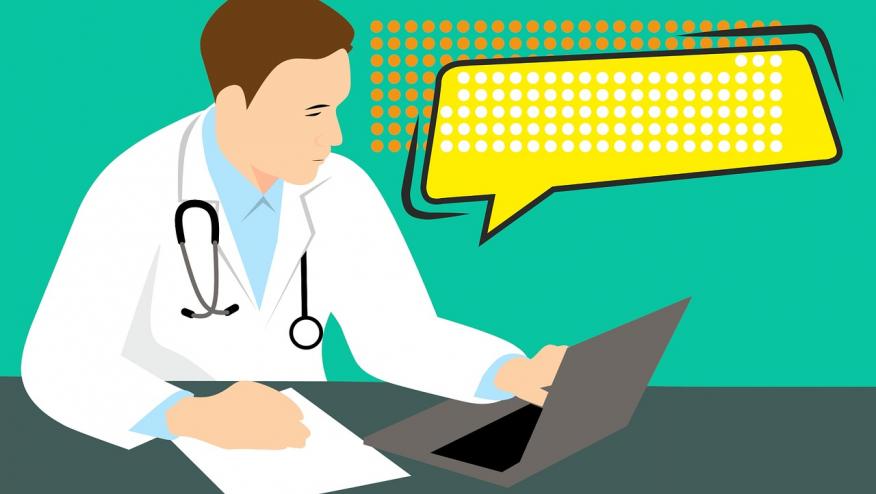Telemedicine Studies: A Trainee’s Perspective Save

COVID-19 brought many changes to our clinical practice, but the shift from face-to-face consultations to telemedicine has been immense for clinicians and patients alike. A simple Twitter poll which I posted on the first day of ACR 2020 showed clinicians and patients consider the shift to teleconsults to be the most important change in rheumatology practice due to the pandemic.
A few months from becoming a rheumatology registrar, I was helping with clinics during the first few months of the UK’s response to COVID-19. Having spoken to other members of the multi-disciplinary team, senior colleagues, and rheumatologists from around the country and globally, it is clear that this was, and continues to be, a time of steep learning for all.
Telemedicine as a concept is not new, as highlighted by Dr Christine Peoples at this year’s congress. Defined as “delivery of healthcare and exchange of healthcare information across distances,” it is poignant to remember that information about the bubonic plague was transmitted through Europe via bonfires.
Given the numerous challenges and nuances in practising telemedicine, it is apt that the ACR 2020 programme has been packed with educational content on this topic, as well as several abstracts covering aspects from patient perspectives to remote monitoring. For attendees in the UK, the Friday evening dinner slot in the schedule brought two fantastic educational sessions on telemedicine. The first was delivered by Dr Aruni Jayatilleke (Session 2F025) on how and when to use telemedicine, with a particular focus on patient priorities. While limitations were discussed, such as lack of ability to do a joint or spine exam, it was noted that there are ways in which we can do better, including the improvement of access to care in rural and underserved populations, sharing resources more widely. Ultimately, the priority should be to keep our patients safe, ensure access, including access to in-person appointments where this is appropriate and necessary.
This was followed by two excellent presentations on telemedicine pre- and during COVID-19, and how this may progress going forward (Session 2F037) by Dr. Christopher Phillips and Dr. Christine Peoples. The sudden arrival of restrictions due to COVID-19 meant we were forced to overcome the barriers previously standing in the way of telehealth delivery: technical, logistical, financial. Prioritisation of reviewing our patients, including new referrals and those in rural communities with travel impositions, was more vital than ever. The striking graphical representations of the reliance on telehealth during the pandemic in the US delivered in this session reflect what many of us have experienced in our own practice.
Important and varied research being done in this area have been peppered throughout the congress. Abstract 0569 sought to explore some of the barriers described above, and patient ability and willingness to utilise telemedicine. One key finding was the limitations of technology in certain demographics such as the elderly population, which highlights the need to ensure we are able to adequately manage patients of all ages and backgrounds. Despite this, several presentations highlighted the improvement in access and uptake in rheumatology appointments through the medium of telemedicine including abstracts 1584 and 0603. Key reasons appear to be improved access for those living in rural communities and with inadequate access to transport which have previously prevented them from attending appointments.
An important and obvious limitation of telemedicine is the inability to examine patients, vital to a specialty such as rheumatology. Several abstracts seek to highlight ways in which to overcome this including work from the Brigham and Women’s Hospital (Abstract 1460) which explored the use of a mobile health app, incorporating voice assistance to virtually assess progression of disease activity and ask other questions about the patient’s rheumatoid arthritis. Adherence to reporting disease activity remained stable over four weeks, although, not all patients appeared to find the voice-assist software useful or satisfactory. It is clear that this is still a novel and growing area of research which I’m sure will yield some exciting work, possibly by the time we meet for ACR 2021.
In the meantime, many clinicians, especially those with access to video consultations, are using novel ways to assess disease activity. Virtual joint examinations such as that which is available on RheumNow (Virtual Video Joint Exam (Updated)) may be something we now have to incorporate into our daily practice.
The world of telemedicine may not be totally new, but it is daunting for patients and clinicians alike, especially from a trainee perspective. It is encouraging to see ways in which healthcare professionals embrace this new way of working to improve the experience for our patients, especially those from difficult-to-reach areas and backgrounds.
The multiple aspects covered at ACR 2020 have certainly added to the telemedicine toolkit we are increasingly needing and using, and I look forward to implementing these in my own clinical practice.










If you are a health practitioner, you may Login/Register to comment.
Due to the nature of these comment forums, only health practitioners are allowed to comment at this time.